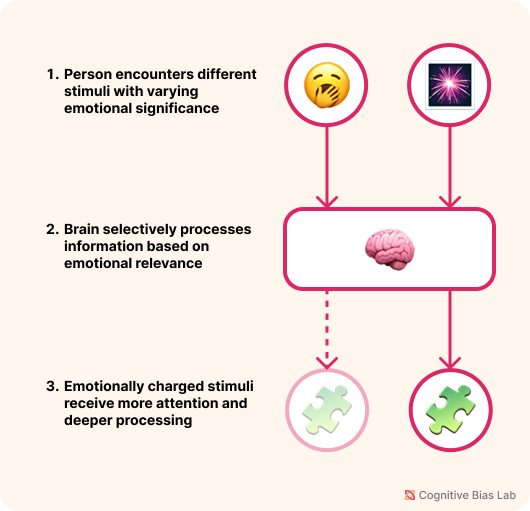Attentional Bias
Your progress on this bias test won't be saved after you close your browser.
Understanding Attentional Bias
Attentional Bias
Our minds naturally gravitate toward emotionally charged information, causing us to fixate on certain details while completely missing other critical data that doesn't trigger the same emotional response.
What is Attentional Bias?
Attentional bias occurs when certain stimuli—particularly those with strong emotional content or high visual prominence—capture and hold our attention at the expense of other relevant information. This mental shortcut causes us to perceive our environment through a selective filter, often without realizing it.
Key Characteristics:
- Emotional triggers disproportionately influence where we direct our focus
- The bias operates largely below conscious awareness
- It can significantly distort risk assessments and decision processes
- Particularly powerful in high-stress environments or when dealing with emotionally charged topics
Real-World Impact:
In professional settings, attentional bias can lead a manager to fixate on a single concerning data point during a quarterly review while overlooking numerous positive indicators. During crisis situations, teams might become hyperfocused on the most alarming aspects of a problem, missing potential solutions or mitigating factors that don't trigger the same emotional response.
Why It Matters:
Understanding attentional bias is crucial because it silently shapes our perception of reality. By recognizing when our attention is being disproportionately captured, we can implement structured approaches to ensure we're considering the complete picture rather than just the parts that naturally demand our focus.

Visual representation of Attentional Bias (click to enlarge)
Examples of Attentional Bias
Here are some real-world examples that demonstrate how this bias affects our thinking:
The Dashboard Distortion
A marketing executive reviews a comprehensive analytics dashboard with twenty different metrics. Upon noticing a sharp 12% drop in social media engagement, she becomes intensely focused on this single negative indicator. During the team meeting, she spends fifteen minutes discussing this decline while allocating only five minutes to review the remarkable conversion rate increase and positive ROI figures. This selective attention leads to a misallocation of resources as the team scrambles to fix the engagement issue while neglecting to capitalize on the successful conversion strategies.
Investment Decision Tunnel Vision
An investor researching potential opportunities comes across a dramatic news headline about a company experiencing unexpected growth. Despite having a systematic evaluation process, they become so captivated by this single positive indicator that they rush their analysis and miss critical warning signs in the financial statements. The investment ultimately underperforms because the attention-grabbing headline overshadowed more reliable but less exciting metrics.
How to Overcome Attentional Bias
Here are strategies to help you recognize and overcome this bias:
Use Standardized Checklists
Apply structured rubrics that require you to evaluate all relevant factors equally before forming conclusions.
Pause to Rebalance Focus
After noticing a strong detail, ask what you're overlooking and take a short pause to consider less obvious but important information.
Test Your Understanding
Challenge yourself with these questions to see how well you understand this cognitive bias:
A team leader notices their project group seems fixated on a small budget overrun while ignoring significant progress on deliverables. What specific technique would best counteract this attentional bias?
Academic References
- MacLeod, C., Mathews, A., & Tata, P. (1986). Attentional bias in emotional disorders. Journal of Abnormal Psychology, 95(1), 15–20. https://doi.org/10.1037/0021-843x.95.1.15
- De Houwer, J., & Koster, E. H. (2023). Attentional biases in anxiety and depression: current status and clinical considerations. World Psychiatry, 22(3), 473–474.
- Kirby, A. S., Jenks, R., Walsh, F., & Duncan, M. (2023). Attentional Biases towards Body-Related Stimuli in Healthy Males: A Systematic review. Psychological Reports, 003329412311772.